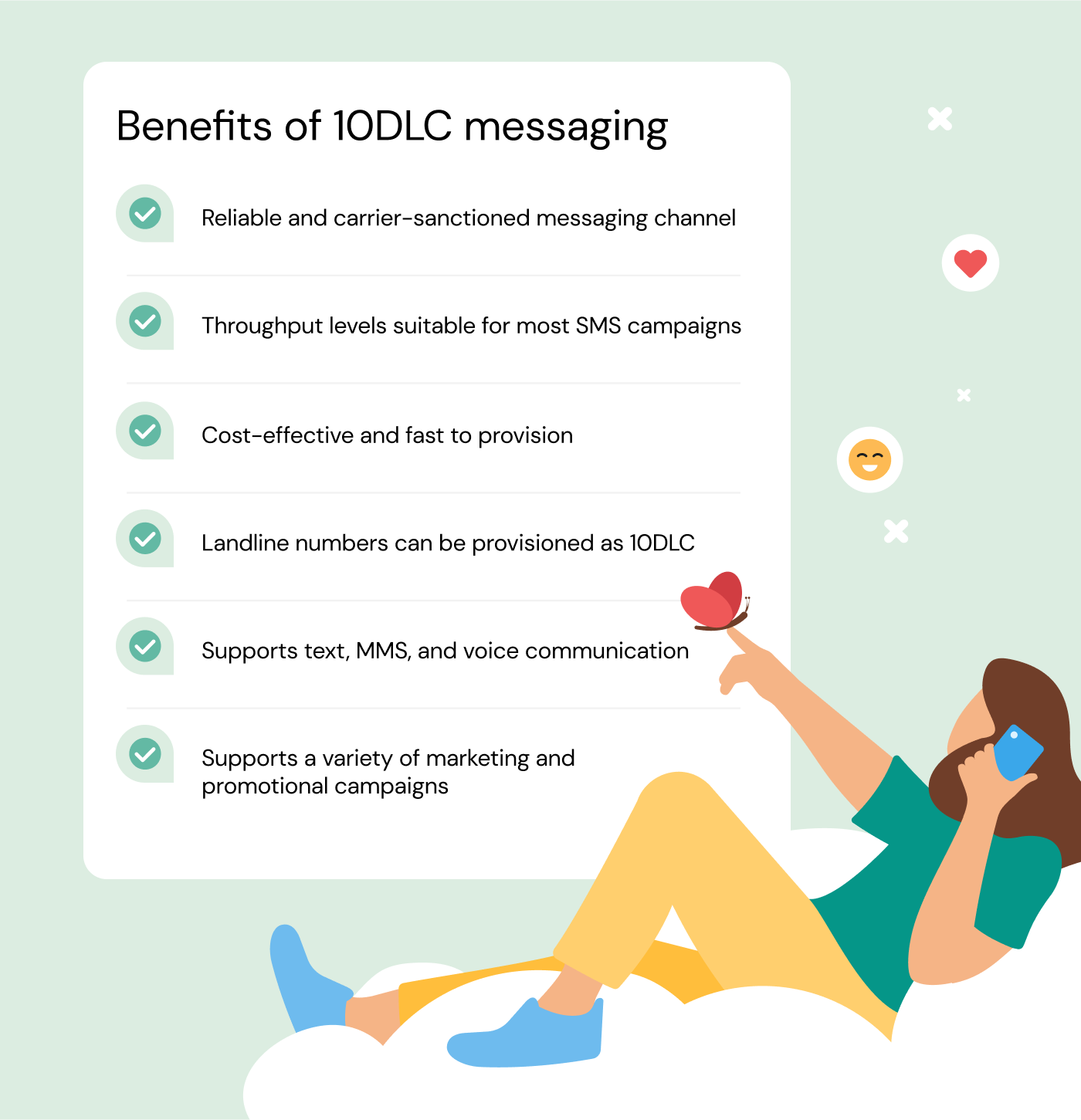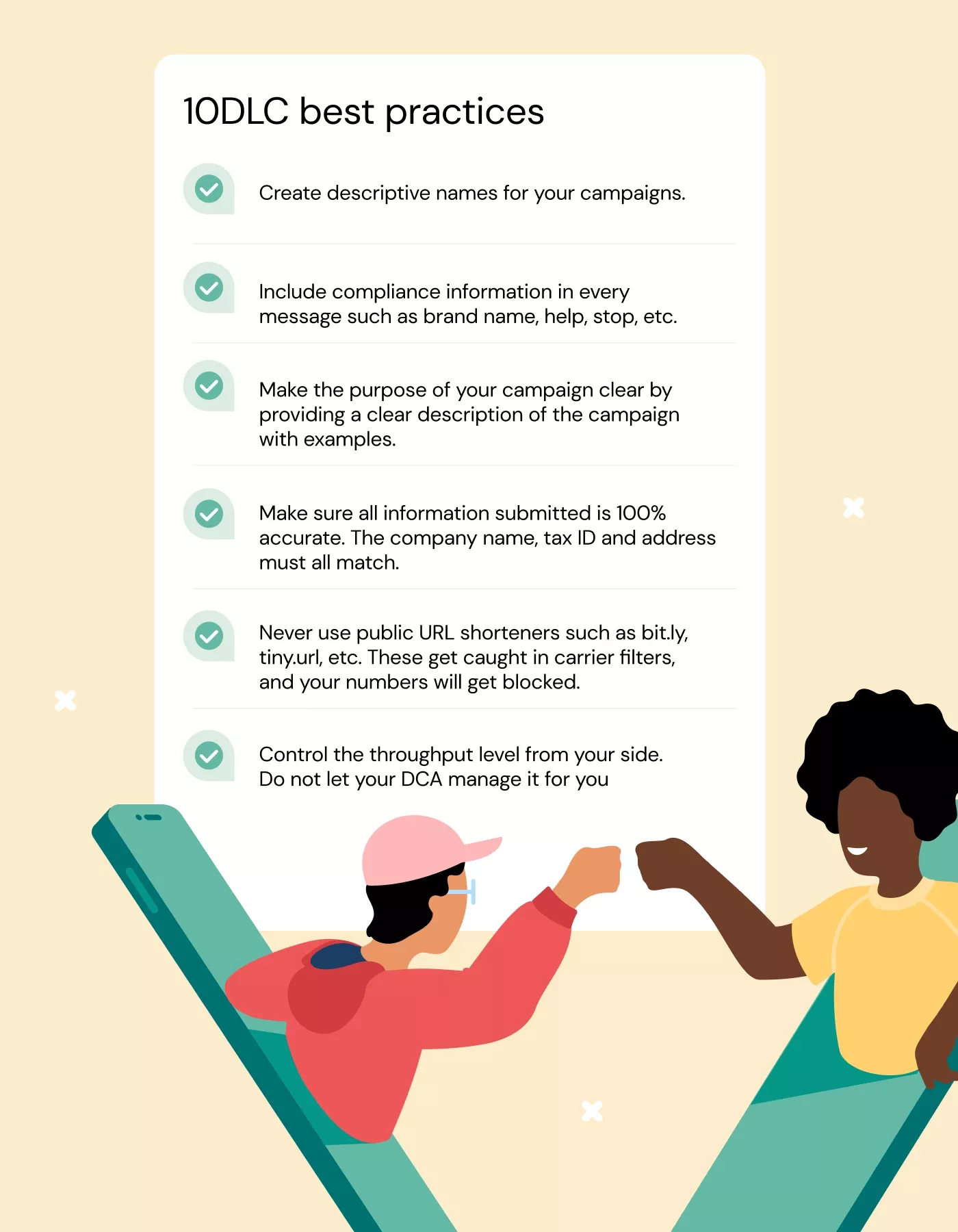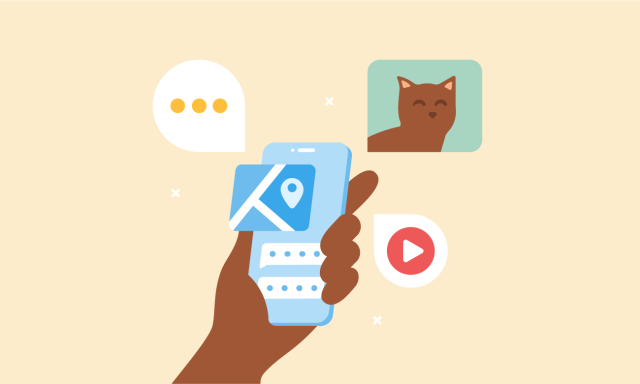If you're in the thick of evaluating customer communication methods, you've likely felt the pinch of conventional messaging. Traditional numbers, while familiar, were designed with person-to-person (P2P) communication in mind, not the hustle and bustle of modern business communication.
And then there are shared short codes – a breeding ground for scams and malware that were even banned by American wireless carriers in 2021. Premium, dedicated short codes are a great solution, but there are still some limitations.
Enter 10DLC (10-Digit Long Code), the new star in application-to-person (A2P) messaging for the U.S. market. It allows you to communicate en masse but with a personal touch and without the usual headaches. It’s efficient, compliant, and cost-effective.
In this guide, we’ll cover what 10DLC is, what its benefits are, which businesses can benefit from it, and how to use it for your brand.
What is 10DLC?
10DLC stands for 10-Digit Long Code. It’s a specialized phone number type that U.S. mobile operators have given a green light for A2P messaging. It allows businesses to send text messages directly to their customers using a 10-digit business (landline) phone number that mirrors the familiar format of personal phone numbers.
This method extends across the North American Numbering Plan (NANP), meaning it's not just available in the U.S. but also U.S. territories, Canada, and the Caribbean are within reach.
So, what’s the big deal? 10DLC allows brands to send text-based communications via SMS and MMS. With 10DLC, you can tailor your outreach to meet diverse customer preferences and needs, all while using a single, compliant, cost-effective business number. Additionally, because these are your business numbers, you most likely have voice enabled on them as well, making 10DLC your one-stop shop for voice, SMS, and MMS messaging.
Whether announcing a new product, offering customer support, or gathering feedback, a 10DLC number equips you with the tools to do so while staying in line with messaging regulations.
10DLC vs toll-free long codes and short codes
Understanding the differences between 10DLC, toll-free long codes, and SMS short codes can be tricky, but also important so you know your options inside out.
10DLC is tailored for business-to-consumer communication and offers a blend of the personalized touch of traditional phone numbers with the efficiency and compliance needed for mass messaging. 10DLC is a great solution for A2P messaging, which makes it a go-to for businesses aiming to reach their audience on a large scale without losing a personal connection.
On the other hand, toll-free long codes are essentially the 1-800 numbers of texting. They support mass messaging and also support voice calls but with the added perk of being free for the end user to send messages to. They’re great for customer service-focused communication.
Meanwhile, SMS short codes are shorter numbers (typically 5 to 6 digits) used primarily for mass mobile marketing campaigns and alerts. They handle a high volume of messages per second, which is great for large-scale one-way blasts, but they can feel less personal and are more heavily regulated.
Each option has its place. 10DLC strikes a balance between personalization and mass communication, toll-free numbers prioritize customer service, while short code numbers cater to high-volume, broad-reach campaigns.
Benefits of 10DLC messaging
10DLC opens up valuable new opportunities to connect with customers. By following a few simple protocols, brands can now reach mobile users via SMS using a 10-digit phone number. Read on to learn how switching to 10DLC can increase engagement, improve message delivery rates, and help future-proof your SMS messaging strategy.
Higher SMS message volumes and throughput
Dispatch your messages swiftly and reach your audience exactly when it matters most with 10DLC messaging. Unlike traditional messaging systems that can bottleneck under heavy loads, 10DLC handles the high-volume demands of modern businesses, ensuring your communication is both timely and efficient.
This is great for businesses where message timing is critical. For example, e-commerce companies launching flash sales, event organizers sending real-time updates, or service providers offering timely customer support can all benefit from 10DLC. Sending large numbers of messages ensures your audience receives important information without delay, directly influencing customer satisfaction, experience, and revenue.
Additionally, 10DLC messaging is ideal for delivering one-time passwords (OTPs) securely and promptly, further enhancing its utility for businesses prioritizing security and seamless user experiences.
Local area code
A message from a local number reduces the skepticism often associated with unknown or generic numbers, while also identifying recipients as being from their area. For example, a restaurant chain using 10DLC to send promotional SMS with updates can use local area codes for each location.
This recognition boosts your message's open and engagement rates – it's like getting a letter from a neighbor instead of a faceless entity from across the country. Customers are more likely to engage with familiar texts and, this way, you build customer loyalty and foster a sense of belonging.
Improved deliverability and reliability
Since 10DLC numbers are registered specifically for A2P traffic, U.S. carriers recognize them as legitimate sources of mass messaging. This 10DLC registration process reduces the chances of your messages being filtered out or rejected as spam.
The benefit here is twofold: your messages reach their intended recipients more consistently and the delivery reliability also improves your brand's reputation. Using a 10DLC number and registering your brand will help with higher message throughput, higher engagement rates, and more successful campaigns overall.
Regulatory compliance
Unlike person-to-person (P2P) long codes, which aren't designed for mass messaging and may violate regulations, 10DLC numbers are ideal for A2P messaging. This means they're pre-approved for the type of mass communication efforts businesses undertake to ensure compliance with industry standards and regulations from the start.
How does this help you?
First, it reduces the legal and operational risks associated with non-compliance, such as fines or messaging service interruptions. Secondly, it streamlines setting up and launching messaging campaigns, saving valuable time and resources.
For example, a health clinic using 10DLC for appointment reminders and health tips can do so knowing their communications align with telecommunications standards, avoiding penalties and ensuring their messages reach their patients without issue.
Regulatory compliance of 10DLC messaging offers peace of mind and operational efficiency. Mobile carriers, including AT&T, Verizon, and T-Mobile, have imposed these restrictions to ensure businesses follow industry guidelines and protect consumers from potential spam or fraud.
You can focus on crafting impactful messages and strategies instead of navigating telecom regulations. Clarity and compliance protect your business and boost customer confidence.
Learn more with our guide to SMS compliance.
Cost-effective with added flexibility
With 10DLC, you're not juggling multiple numbers or platforms – one number supports SMS, MMS messages, and voice communications. This unified approach simplifies your messaging infrastructure and reduces costs for managing separate channels for different communications.
For starters, it provides a more cohesive communication strategy where you can tailor and adapt messages without needing multiple numbers or systems. This is great for small and medium-sized businesses (SMBs) that may need more resources for complex messaging setups.
Retailers can send promotional texts, multimedia product highlights, and voice call follow-ups from the same business number to improve the customer experience while keeping costs in check.
Supports a great customer experience
10DLC messaging improves customer experience and allows you to build long-term relationships with your audience.
High deliverability rates ensure your messages reach your customers without getting lost or falling victim to spam filtering. Plus, a local business number adds a personal touch and makes your communications feel more friendly and less intrusive. These elements combined create a seamless and engaging customer journey, from the initial contact to ongoing engagement.
Maintaining consistent touchpoints with customers through a reliable and familiar channel improves overall brand perception. Customers are more likely to engage with and respond to messages they trust and recognize.
Apart from this, 10DLC's adherence to regulatory compliance requirements ensures customers feel safe and respected. This compliance protects businesses from potential legal issues and reassures customers you’re handling their data responsibly.

Six benefits of 10DLC messaging.
Who should use 10DLC?
A2P 10DLC is excellent for a wide range of businesses that need to send alerts, reminders, OTPs, or promotional content. It's especially critical for you if you rely heavily on notifications to keep your audience engaged and informed. Here are some businesses that should use 10DLC.
Retailers
Retailers can use 10DLC to build more personalized and responsive customer relationships. It enables a direct and effective way to reach customers to improve engagement and sales. Here are some retail use cases for 10DLC:
-
Send targeted promotions and discounts directly to customers and encourage immediate action.
-
Automatically confirm orders to provide customers with peace of mind immediately after purchase.
-
Keep customers informed with real-time updates on the status of their deliveries.
-
Gather valuable feedback by sending surveys post-purchase or post-interaction.
-
Alert customers to in-store events, sales, or VIP shopping sales.
-
Share updates about loyalty points, rewards, and exclusive offers to engage and retain customers.
-
Provide OTPs to consumers trying to log into their accounts.
Enterprises that need cost-effective messaging
Enterprises constantly seek efficient, cost-effective ways to communicate with their audience, and 10DLC offers just that, bringing the perfect blend of affordability, scalability, and reliability. Enterprise use cases for 10DLC can include:
-
Share company news, policy updates, or important alerts to employees and stakeholders.
-
Send event reminders or internal survey links to boost employee involvement.
-
Alert customers and partners about new product releases or updates.
-
Provide timely notifications during critical situations to ensure safety and continuity.
-
Integrate with CRM systems for automated customer communications like appointment reminders or service feedback requests.
Businesses focused on compliance
If you operate in an industry that prioritizes compliance like healthcare, finance, and education, you’ll find 10DLC a critical asset. It aids compliance, offering peace of mind and reducing the risk of penalties. Types of businesses in this category include:
-
Nonprofits can engage with donors, volunteers, and beneficiaries about fundraising events, program updates, and emergency assistance efforts to ensure messages are respectful and comply with solicitation laws.
-
Healthcare providers can send appointment reminders, patient care follow-ups, and public health notifications, all while adhering to HIPAA regulations.
-
Financial institutions can deliver OTPs, account alerts, fraud warnings, and transaction confirmations to ensure compliance with financial communication regulations.
-
Educational institutions can communicate with students and parents about emergencies, school events, and academic reminders in a manner that respects privacy laws.
-
Government agencies can issue public safety announcements, community alerts, and citizen engagement messages that follow government communication standards.
For businesses and organizations in these sectors, 10DLC provides a framework that respects the stringent regulatory requirements inherent to these industries.
Best practices for 10DLC campaigns
Now that you know the basics of 10DLC, let's discuss some best practices for running effective campaigns. Applying these tips will help you create relevant messaging, drive engagement, and get the most out of the 10DLC platform.
-
Create descriptive names for your campaigns to help recipients understand the context immediately, enhancing engagement. Choose names that reflect the campaign's intent and content, making it easier for users to recognize and trust your messages.
-
Include compliance information in every message such as including your brand name, and instructions for "help" and "stop" to opt-out. Brand recognition, transparency and opt-out instructions satisfy regulatory requirements and build trust with your audience.
-
Provide a clear description of your campaign because a well-articulated campaign purpose removes ambiguity and sets the right expectations. For example, if your campaign concerns customer feedback, specify this to avoid confusion.
-
Ensure all submitted information is accurate as your company name, tax ID, and address must all match your official records. Accuracy is key to avoid delays or rejections in campaign approval.
-
Avoid public URL shorteners since U.S. carriers often block messages containing links from programs like bit.ly or tiny.url, which are often fraudulent. Instead, use branded/private paid-for short links to maintain message integrity and deliverability.
-
Control the messaging throughput level to maintain quality and avoid carrier penalties. It’s better to handle this internally than rely on your connectivity partner to manage it.

Six best practices for 10DLC campaigns to maximize impact.
Get started with 10DLC
Getting started with 10DLC is a simple two-step process: registering your brand and campaign information. One brand can have multiple campaigns, and each customer can have multiple brands. As you’ll see, choosing the right SMS provider can make all the difference when navigating the nuances of 10DLC.
Step 1: Register your brand
To send 10DLC campaigns, brands must register with The Campaign Registry (TCR):
-
If you’re not a Content Service Provider (CSP), Sinch can manage all your registration needs. Get in contact with our team, and then we'll ask you for your company name, tax ID, and contact details so we can take care of the rest.
-
Or, if you're a CSP, visit TCR and select "Register Now". Then, as you set up your customers’ Brand and Campaign information within TCR, you can select Sinch as your DCA (Directly Connected Aggregator).
-
Ensure your company information is 100% accurate – inaccuracies will delay your 10DLC launch. If you enter incorrect information, you may be in an “unverified” state, and you won’t be able to continue.
Once registered, TCR will verify your identity and assign a brand trust score. You should promptly fix any issues before running campaigns.
You’ll also need to review throughput needs beforehand. Depending on the carrier, throughput is determined based on factors such as brand vetting score, type of campaign, and use case. You should review your daily volume needs beforehand to ensure higher throughput.
Need higher volumes? Vetting is optional but recommended for higher throughput. Choose standard vetting (a basic identity check) or enhanced vetting (2-4 week investigation). Vetting level determines your brand score and carrier throughput allotment. We recommend at least going through a standard vet for all brands.
Step 2: Register your campaign
Once your brand has been verified, and hopefully vetted, register your messaging campaigns through with these steps:
-
If you’re a Sinch customer, log in to the Customer Dashboard and enter in your campaign information from the left side menu under “SMS.” If you’re a CSP, log into the TCR portal, select "Register Campaign" and choose Sinch as your connectivity partner.
-
You can have multiple campaigns per brand, but each campaign can only belong to one brand.
-
Provide a campaign description, opt-in flow, sample messages with HELP and STOP responses, terms and conditions and privacy policy links, opt-in/out details, and any applicable mobile originated (MO) opt-in keywords.
-
For all campaigns, don’t forget to include your “call-to-action" and opt-in/out specifics.
After registering, Sinch, or TCR, will generate your unique campaign ID.
Step 3: Purchase or port your 10DLC numbers
The next steps involve getting 10DLC numbers for your campaigns and having them text enabled. At Sinch, we can assist with both.
Throughput is set at the number/campaign level (AT&T) or brand level (T-Mobile). If porting an existing number, you must provide Letters of Authority.
Prior to 10DLC you may have used many numbers to send your messages and stay below throughput thresholds. With 10DLC however, you can now send all 10DLC messages from a single number. You don’t need to spread your traffic over multiple numbers (snow shoeing).
Step 4: Submission
If you’ve registered your 10DLC campaigns with Sinch and tied your numbers to the campaigns, you’re all set to go. Start messaging!
If you’re a CSP, and have registered your brand and campaign in TCR, and selected Sinch as your DCA we’ll take it from there. We’ll do all the back-end work and once your campaign has been reviewed and approved, you’ll be all set to go.
Contact a 10DLC expert
Contact our team of experts at Sinch to begin the approval process and improve your business text messaging experience. With our guidance, you can get set up on 10DLC quickly and maximize customer engagement with impactful messaging.



